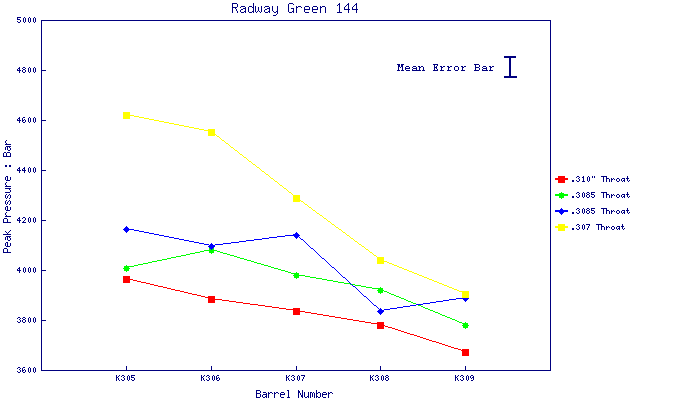
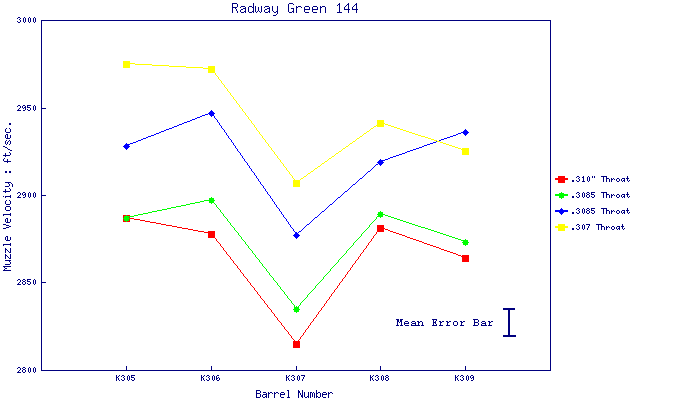
|
AN INVESTIGATION INTO THE EFFECTS OF TIGHT THROAT AND BARREL DIMENSIONS ON MAXIMUM CHAMBER PRESSURES FOR THE 308 WINCHESTER CARTRIDGE (A pdf version of this paper is available)
This investigation carried out by
THE PRESSURE TRIALS CONSORTIUM
Members Mr. John Carmichael, Mr. Alan Gidman, Mr. Roger Hancox,
INTRODUCTION
The Pressure Trials Consortium was formed to address a problem that had become generally apparent to ammunition makers, firearms industry standards regulators and shooting organisations throughout the world. The problem is mainly confined to those concerned with target shooting sports, but is also one faced by all those interested in achieving the best accuracy from any given ammunition. It has been found that to achieve good accuracy from any given ammunition, it is usually necessary to use tight throat dimensions and/or barrel dimensions, which may be tighter than the minimum specified by the bodies that regulate cartridge, chamber and barrel dimensions. (The C.I.P. Federation, though S.A.A.M.I. in the United States). Ammunition manufacturers test their ammunition in specially made test barrels which are made to the minimum dimensions permitted by the relevant regulatory body. That ammunition is then approved for use in barrels which meet the relevant dimensional standards, but using that ammunition in barrels whose dimensions are smaller than the standard permits will result in higher chamber pressures than those measured in the test barrels. The pressures could be pushed above the statutory upper limits and so be dangerous for general use. It is well known that firearms subjected to a diet of high or over-pressured ammunition can suffer progressive stress fatigue and eventual catastrophic failure. The usual proofing requirement that the firearm should retain its integrity after firing a single overcharged cartridge cannot detect more gradual failure modes which may manifest themselves only after some hundreds or even thousands of rounds have been fired at higher than usual pressures. As chamber pressures are increased, though, the first component to exhibit failure is usually the cartridge case. Splits in the case, pierced primers or enlarging of the primer pocket will allow hot, high pressure gasses to invade the action mechanism. Unless such eventualities have been anticipated at the design stage, these gasses could escape and be directed at the shooter's face or other exposed body parts. No statutory mechanism exists to ensure that firearms actions are designed to handle such gas escapes safely. When using commercial ammunition, Firearms with tight barrel and/or throat dimensions will be subjected to higher pressures than the ammunition was initially designed to produce. There is thus an increase in the probable incidence of gas escapes due to case failure and of catastrophic failure of the firearm itself in the medium to long term. The problem is that there has been no hard experimental evidence to confirm just how much the pressures would increase as the barrel and throat dimensions were decreased, and so there was no certain way of quantifying the danger of such practices. Because of this, it has been hard for regulatory bodies such as the C.I.P., or shooting organisations such as the National Rifle Association, to judge how to respond to the potential risks. Ammunition makers too are tempted maximise the ballistic performance of their ammunition by loading near to the top limits of allowed pressure, as measured in a test barrel of standard dimensions. They can download their ammunition to account for its possible use in a firearm with tight barrel and throat dimensions. But judging the amount by which the ammunition should be downloaded is only a guess without hard evidence as to the effects of tight barrels and throats on chamber pressures. In response to this common problem for the shooting industry, the Pressure Trials Consortium was formed to try and provide the hard evidence needed. The first meeting of the Consortium to determine the experimental programme was held on 14th of August 1996 at the Birmingham Proof House. THE EXPERIMENTAL PROGRAMME
The cartridge.
The test barrels. The barrel dimensions (in inches) and designations were as follows:
Note that due to a problem in manufacture, barrel K307 was shorter than the other four. This should have no effect on the pressure trials, but the muzzle velocity would be expected to be less than the other barrels. The barrels were made from type 416 S21 steel. They had four grooves with a groove width of .175" and a 12" rate of twist. The pressure ports were made as per the C.I.P. standard and were set radially into the chamber, 25mm from the bolt face datum. The pressures were measured using type 6215 Kistler piezo transducers. In addition, two barrels made to C.I.P. standard dimensions were used as control barrels. For these barrels, the bore diameter was .300", the groove diameter was .3080" and the throat diameter was .310".
Throat dimensions. It was appreciated that increasing the throat diameter might also affect the bullet seating so that it no longer touched the lands. A chambered barrel stub was used as a loading gauge to test for overall length required to touch the lands. As the test barrel throats were altered, so the barrel stub was similarly altered. All the pressure trials were run with the bullets loaded out to touch the lands. In addition, however, one pressure trial was run with the throat diameter of .3085" and the bullets seated .009" off the lands.
The ammunition. In addition, one commercial brand of ammunition would be used and the Radway Green 7.62 x 51mm target ammunition (Green Spot, batch No. 22-04-96Y) was chosen. This ammunition was not altered in any way. It used the NATO standard 144 grain bullet and was loaded to an overall length of 2.790". Bullet diameter was .3085". The bullet construction was of the "FMJ" type, with the jacket formed over the core leaving be base open. The bullets were also cannelured and crimped into the cases. Initial pressure trials were run in the standard C.I.P. control barrels to determine the loads to be used. Initially, it was the intention to load so that all the ammunition produced 4150 bar in the control barrels, this being the maximum allowable sample average of the peak pressures for any batch of C.I.P. approved ammunition. However, it did not prove possible to achieve this pressure using the chosen powders with the 155 grain bullet. It was eventually decided to settle on an average pressure of around 3700 bar for all the ammunition.
Note that the CIP Maximum Permitted Pressures for the 308 Win. Cartridge are: Sample Average 4150 bar, Maximum for Any Single Cartridge in Sample 4773 bar.
Experimental procedure. For each trial, five rounds of each of the five varieties of ammunition were fired in each of the five barrels. An average and a standard deviation were computed for each series of five rounds. The pressure results are shown in the graphs attached. The graphs are titled as Bullet type/Powder type. So for example, the S200/N540 graph shows Peak Pressures using the Sierra 200 grain Match King bullet and the Vihtavuori N540 powder. Velocities were also measured using light-screen chronographs. The "start" and "stop" timing screens were placed five and six metres in front of the test barrels. The results are shown in graphs attached, titled as for the pressure graphs.
DISCUSSION. It should be noted that where the groove dimension of the barrel was larger than the throat diameter, it might be expected that the effects of the tight throat would not be as great as for those barrels where the groove diameter was smaller than the throat diameter. However, no real differences were observed between "tight" barrels and "loose" barrels in this respect. The pressures for the K305 barrel are generally lower than the pressure rise trend in the other barrels would suggest they should be, and in most instances they are lower than the K306 barrel pressures. It was noted that the area of the chamber wall around the pressure port for the K305 barrel was blackened and carbonised to a greater degree than the other barrels, suggesting a leakage of gasses around the outside of the case in this particular barrel. This, despite the fact that there was no discernible dimensional difference for the chamber of this barrel compared to the others. The standard deviations on the pressure measurements for this barrel were also slightly higher on average than the other barrels, which would tend to support this gas leakage scenario. The results for the K305 barrel are therefore to be treated with circumspection. Without the gas leakage, it is reasonable to conclude that the pressures for the K305 barrel would have followed the trend of pressure vs. barrel dimensions shown by the other barrels. The velocity measurements are not unreasonable, when compared to the predictions of a relatively simple internal ballistics model, but they do show some unexpected features. The velocities increase as the throat diameter is decreased, particularly with the .307 throat diameter, but despite significant increases in pressure, the velocities remain remarkably constant for any given ammunition variety as the barrel dimensions are decreased, but particularly so when using the 200 grain bullets. This was quite unexpected and created some doubt regarding the apparatus used to measure the muzzle velocities. The exception was the shorter K307 barrel which did give lower velocities than the other barrels, which was expected. It is possible to derive the constants for the well known Leduc equation for bullet velocity as a function of barrel length, using the muzzle velocity, the peak pressure, the load and the length of barrel. If we assume that had the K307 barrel been 24" long, the muzzle velocities would have been the same as the K306 and the K308 barrels, we can calculate what muzzle velocity we would expect if the barrel was reduced to 21.5". The results agree very well with the actual velocities measured with the K307 barrel. It is reasonable to conclude, therefore, that there was no apparatus malfunction. The lack of sensitivity of muzzle velocity to barrel dimensions can be explained if we assume that the friction of the bullet in the barrel increases as the barrel dimensions decrease. This is a departure from the usual scenario, which is that once the bullet has been swaged down to the rifling form by the throat or leade of the barrel, the bullet-to-barrel friction is a constant, regardless of how much work had to be done on the bullet to swage it down. Thus the same bullet would experience the same frictional forces when going down a .308" groove diameter barrel as it will going down a .305" groove diameter barrel. These experiments show evidence that this may not be the case. It should be remembered that in these experiments the loads are being kept the same and changes on pressure and velocity are being looked at as a function of barrel dimensions. This is at odds with the normal hand-loader approach, where the barrel dimensions are being kept the same and the load is being varied. In these latter circumstances, changes in the load would be expected to result in pressure changes which go as the square of the load and velocity changes which are proportional to the load.
CONCLUSIONS and RECOMMENDATIONS It was shown that with decreases in barrel and throat dimensions of the order of 1%, all the varieties of ammunition tested were shown to have their sample Peak Pressure average increased well beyond the 4150 bar limit for C.I.P. approved ammunition, despite having reasonable working pressures below this limit in a standard test barrel. Barrels with a bore dimension of .298" and a groove dimension of .3065 are typical of a large number, if not the majority, of barrels used in the sport of Fullbore Target Rifle shooting. Most of these barrels have throat diameters of .3085" or less. Commercially available, C.I.P. approved ammunition could be potentially dangerous in rifles with tight throat and barrel dimensions. The idea that tight barrels produce higher muzzle velocities and so improve the long range ballistic performance of the ammunition has become received wisdom in target rifle shooting circles. These experiments indicate that this hypothesis is of limited validity. For longer barrels than those used for these experiments, the reverse might well be the case, particularly with heavy bullets having a large bearing area. The increased muzzle velocity observed in tight target rifle barrels is most probably due to the tight throats those barrels will invariably have. The most likely cause of injury would be from the hot, high pressure gasses due to cartridge case failure - particularly in actions not designed to handle such gas escapes safely. These findings, though particular for the 308 Winchester ammunition, may reasonably be generalised to all ammunition calibres and types. As a general case, the Pressure Trials Consortium would recommend that ammunition is never used where the bullet diameter is larger than the throat diameter of the chamber and where the bullet forms an interference fit in the throat.
ACKNOWLEDGEMENTS Firstly, we should like to thank the Birmingham Proof House for the use of its pressure and velocity measuring facilities and its proof range, where these trial were conducted. In particular, we should like to thank Graham Jordan of the Proof House staff for his considerable help and dedication in completing these trials. We are also indebted to the Birmingham Proof House for their hospitality when we held our meetings in the their Guardians Meeting Room. Accuracy International Ltd. were good enough to provide the Sierra bullets needed for the trials. Royal Ordnance, Radway Green provided primed cases and commercial ammunition. Border Barrels Ltd. provided the test barrels and one of the control barrels. JHC Supplies loaded all the ammunition used in these trials, with the exception of the Radway Green commercial ammunition. The National Rifle Association provided funds to purchase the powder used in the ammunition, and to publish this report. A special mention too should be given to John Carmichael, of this consortium, for his time and efforts in performing the experiments and acquiring the data presented here. |

 |
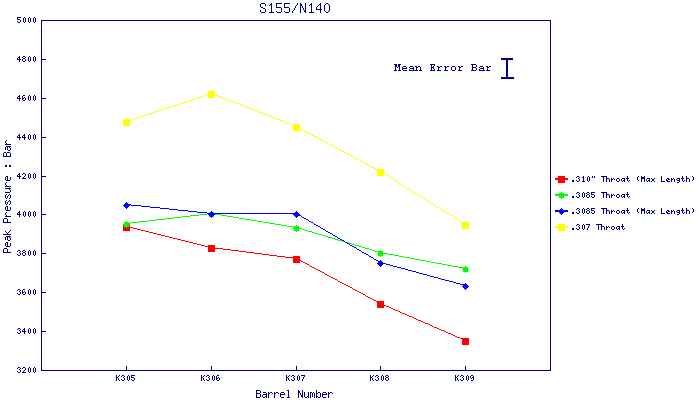
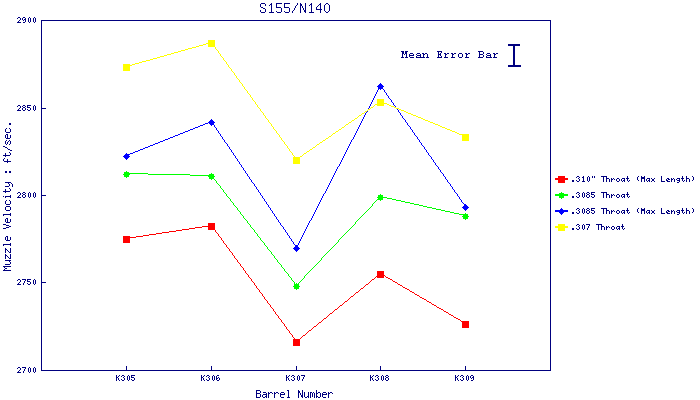 |
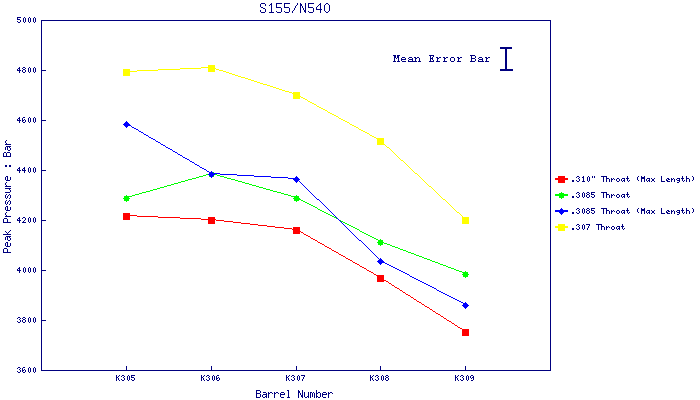
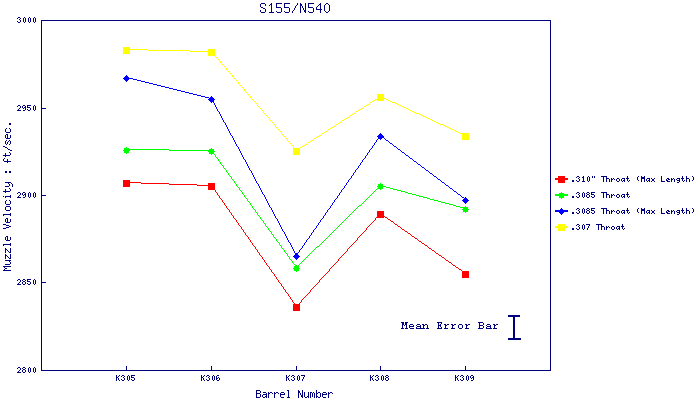 |
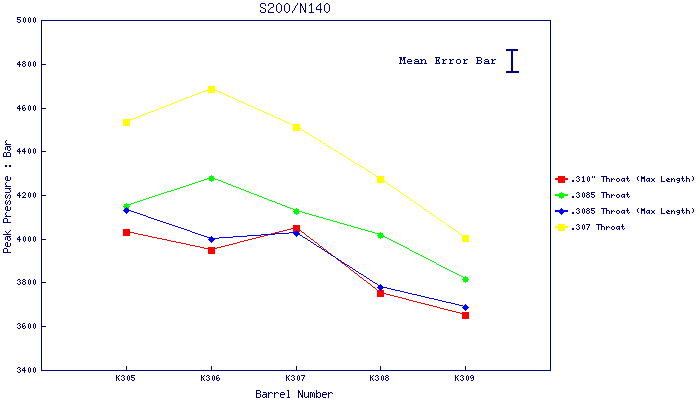
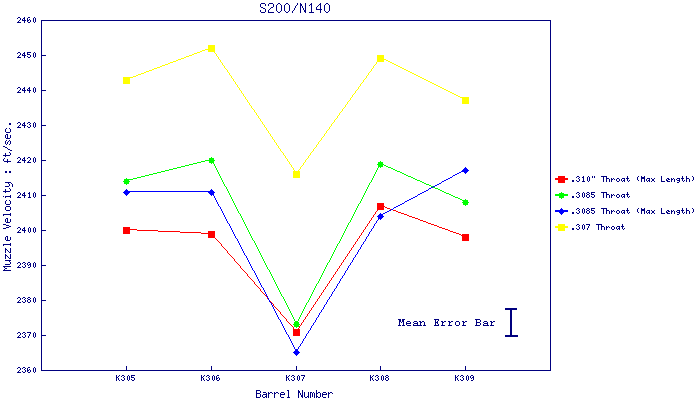 |
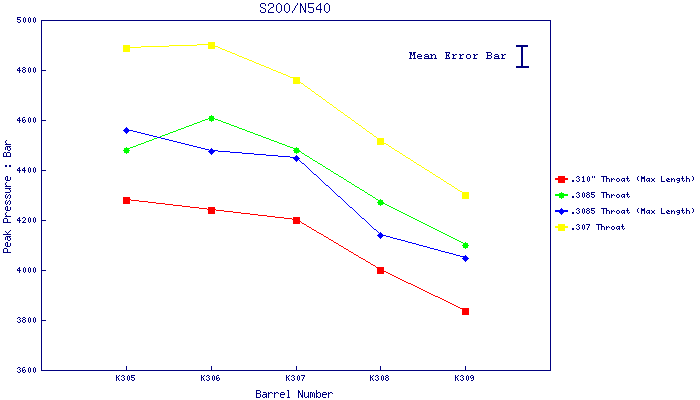
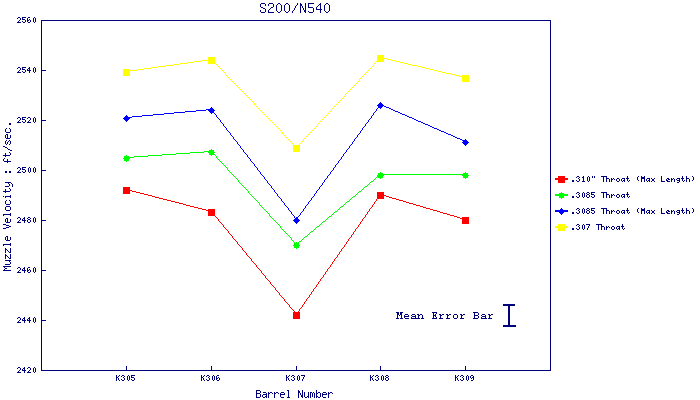 |